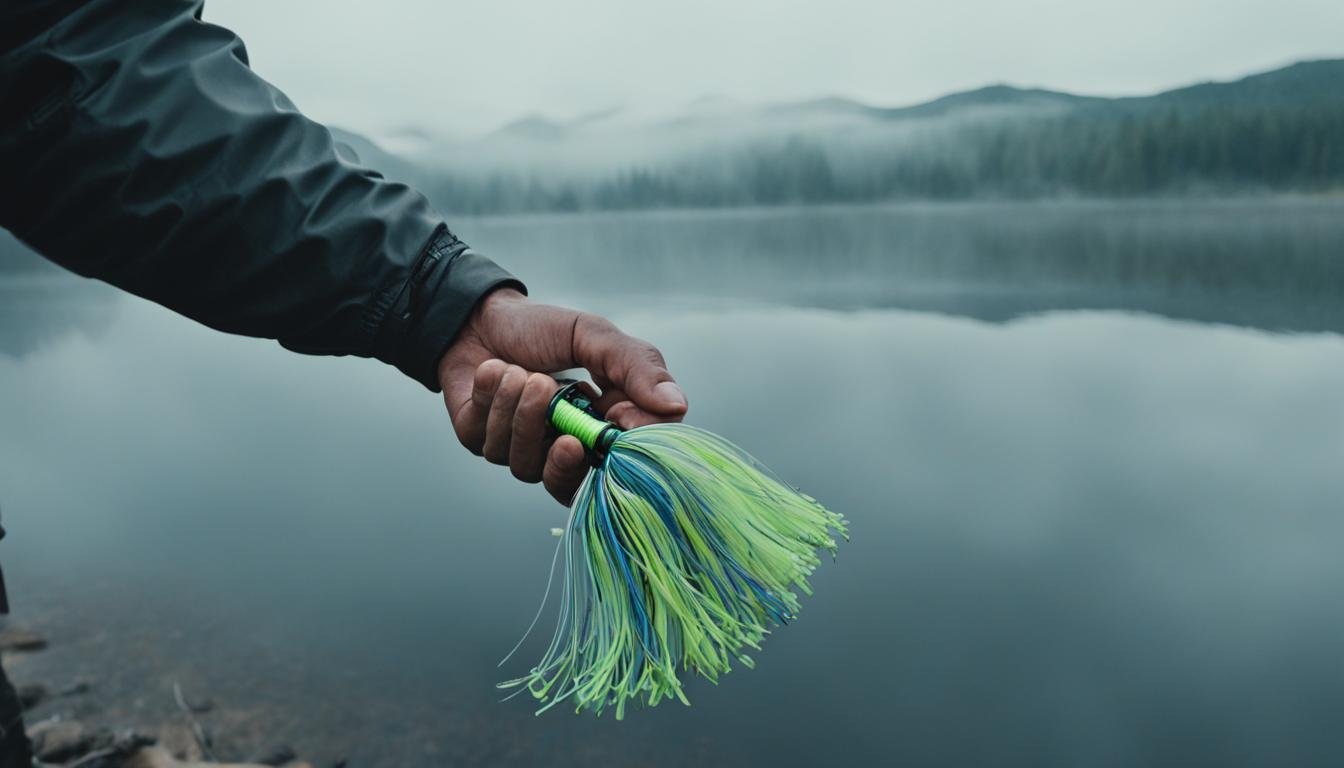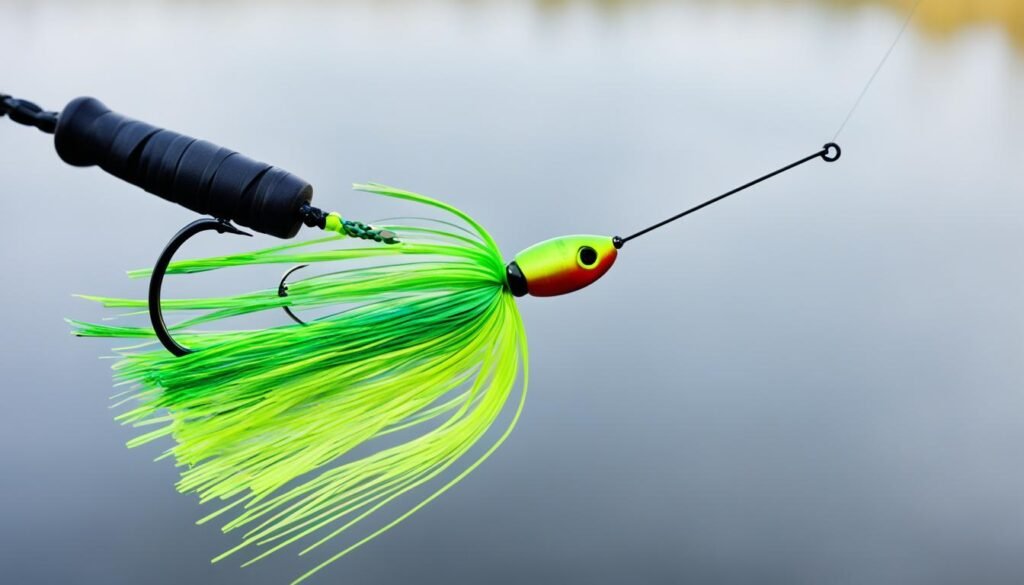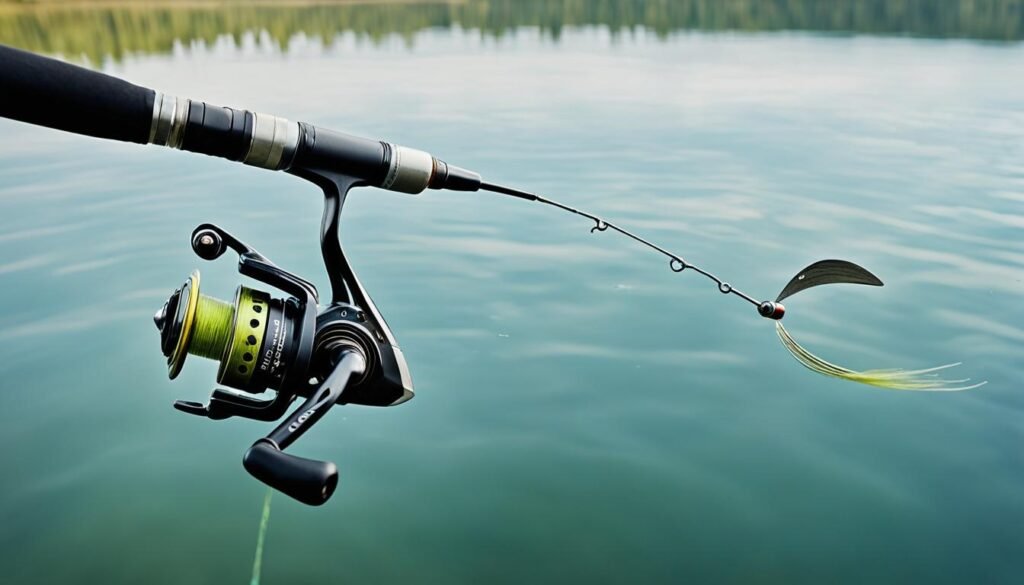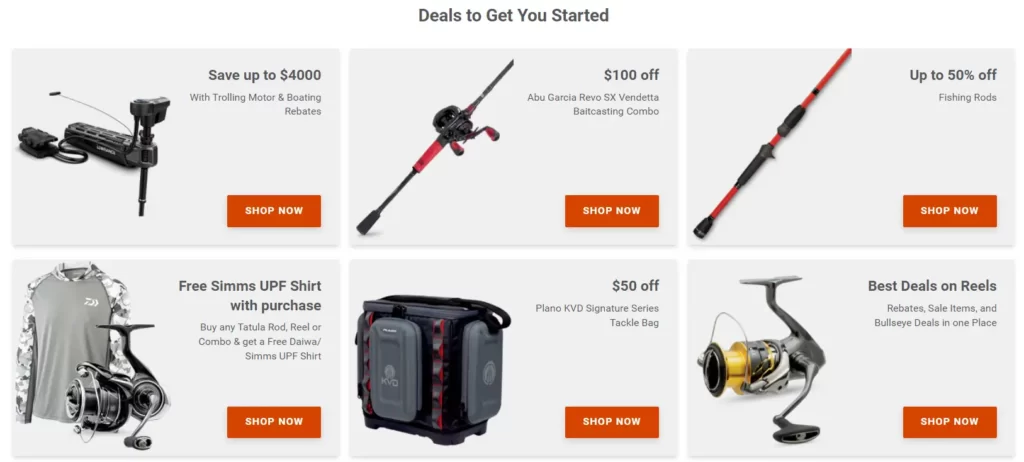Explore Canada's Ultimate Fishing, Hunting, and Wildlife Adventures

Table of Contents
Welcome to the ultimate guide on mastering the art of chatterbait fishing! Whether you’re a novice angler or a seasoned pro, this comprehensive article will equip you with the tips and techniques you need to maximize your success with the chatterbait.
Get ready to learn the secrets of effectively fishing a chatterbait and increase your chances of landing more fish.
Chatterbaits have become a favorite among anglers for their versatility and ability to attract a wide range of fish species. With its unique design and vibration, the chatterbait is a highly effective lure that mimics the movements of natural prey, triggering the predatory instincts of fish and enticing them to strike.
Key Takeaways:
- Learn essential tips and techniques to master chatterbait fishing
- Understand the unique design and components of a chatterbait
- Discover how to choose the right chatterbait for different fishing conditions
- Explore the importance of vibration in attracting fish
- Master the basics of casting and retrieval techniques
Understanding the Chatterbait and Its Unique Design
In this section, you will learn about the unique design of the chatterbait and how its components work together to attract fish. Explore the anatomy of a chatterbait, including the weighted jig head, skirt, and the distinctive hexagonal blade. Understand the importance of the blade in creating vibrations and noise that entice fish to strike the lure.
The chatterbait design is crafted to mimic the natural movements and appearance of prey in the water. It consists of a weighted jig head, a silicone skirt, and a blade that sets it apart from other lures. The weighted jig head provides balance and stability, allowing the chatterbait to swim smoothly through the water.
The skirt, made of thin strands of silicone or rubber, adds a lifelike element to the lure. It creates a flowing, undulating motion that imitates the movement of small fish or insects, attracting the attention of nearby predators. Additionally, the skirt creates a natural-looking silhouette, further increasing the bait’s appeal.
One of the key components of a chatterbait is the hexagonal blade, also known as the chatterblade or vibrating blade. This unique feature is designed to generate vibrations and produce noise as it moves through the water. These vibrations and noise closely mimic the sounds and movements of distressed prey, triggering the predatory instincts of fish and enticing them to strike.
The hexagonal shape of the blade is crucial as it allows for maximum vibration and water displacement. As the blade moves back and forth, it creates a “chattering” sound and sends out strong vibrations that can be detected by fish through their lateral lines. The combination of visual appeal, lifelike motion, and enticing vibrations make the chatterbait an irresistible target for predatory species.
Choosing the Right Chatterbait: Weight and Blade Considerations
When it comes to chatterbait fishing, selecting the right lure is essential for maximizing your chances of success. Two important factors to consider are the weight of the chatterbait and the size of its blade. By understanding how these elements affect the lure’s performance, you can make informed choices that will enhance your fishing experience.
Identifying the Proper Weight for Depth Control
The weight of a chatterbait is crucial for achieving the desired depth during your fishing expedition. Lighter chatterbaits are ideal for fishing in shallow water, while heavier options can help you reach deeper depths. Consider the fishing conditions, such as water depth and current strength, to determine the appropriate weight for your chatterbait. This will ensure that your lure stays at the right depth and effectively attracts fish.
Selecting Blade Size for Optimal Vibration
The blade of a chatterbait is responsible for creating vibrations and attracting fish. The size and shape of the blade can significantly impact the lure’s performance. Larger blades produce stronger vibrations and can be more effective in murky water or when targeting aggressive fish. Smaller blades, on the other hand, provide subtle vibrations that can entice finicky fish in clear water. Experiment with different blade sizes to find the optimal vibration that appeals to your target species.
Disclosure: When you purchase a service or a product through our links, we sometimes earn a commission, at no extra cost to you.
It’s important to note that choosing the right weight and blade size may also depend on specific fishing conditions and target species. Factors such as water temperature, water clarity, and fish behavior can influence which chatterbait is most effective. Take the time to assess these variables and make adjustments accordingly to maximize your chances of a successful catch.

| Chatterbait Weight | Blade Size |
|---|---|
| Lighter weight | Smaller blade |
| Shallow water fishing | Clear water fishing |
| Heavier weight | Larger blade |
| Deeper water fishing | Murky water fishing |
The Importance of Vibration: How Chatterbaits Attract Fish
Vibration plays a key role in attracting fish to a chatterbait. The unique design of the chatterbait, with its hexagonal blade, creates vibrations and noise that mimic the movements of natural prey. These vibrations trigger the predatory instincts of fish, enticing them to strike the lure.
To effectively attract fish with a chatterbait, it’s essential to understand how to manipulate its vibration. By varying the retrieve speed and imparting subtle rod movements, you can control the intensity and frequency of the chatterbait’s vibrations. This allows you to mimic different types of prey, such as injured baitfish or crayfish, and increase your chances of enticing strikes.
To maximize the fish-catching potential of your chatterbait, here are some tips and techniques for using vibration effectively:
- Vary your retrieve: Experiment with different retrieval speeds, ranging from slow to fast, to find out what triggers the most bites. Sometimes a steady retrieve with a consistent vibration is effective, while other times a stop-and-go retrieve that pauses to let the bait fall can entice strikes.
- Twitch your rod: By twitching your rod tip during the retrieve, you can create irregular vibrations that imitate the movements of wounded prey. This erratic action can be particularly effective in triggering aggressive strikes from predatory fish.
- Target high-vibration areas: Fish are attracted to areas with natural vibrations, such as around submerged vegetation or near rocks. By fishing your chatterbait in these high-vibration areas, you can blend in with the natural surroundings and increase your chances of attracting fish.
Remember, the key to attracting fish with a chatterbait is to create vibrations that mimic the natural movements of prey. By mastering the manipulation of vibration and experimenting with different techniques, you can enhance the allure of your chatterbait and increase your chances of catching more fish.
How to Fish a Chatterbait: The Basics of Casting and Retrieval
Mastering the basics of casting and retrieval techniques is essential for successful chatterbait fishing. By honing your skills in these areas, you can effectively target fish and increase your chances of landing that prized catch. Here are some essential tips to improve your chatterbait fishing technique:
- Casting a Chatterbait: To cast a chatterbait, start by holding your rod at a 45-degree angle with your dominant hand at the reel and your other hand gripping the rod. Aim your cast towards the desired location, and with a smooth motion, release the lure while simultaneously releasing the fishing line. Practice your casting accuracy to ensure you can reach your desired fishing spots effectively.
- Retrieval Methods for Chatterbaits: Experiment with different retrieval methods to find the one that works best for your fishing scenario. Some common retrieval techniques include:
“Slow Rolling:” This retrieval technique involves reeling in the chatterbait at a slow and steady pace, allowing the lure to stay near the bottom. It is particularly effective in weedy areas where fish tend to lurk.
“Burn and Kill:” This technique involves reeling in the chatterbait quickly and then abruptly pausing or “killing” the retrieve. The sudden stop can trigger aggressive strikes from fish.
“Stop and Go:” With this method, you retrieve the chatterbait for a short distance, then pause and let it sink before resuming the retrieval. This imitates the erratic movements of injured prey and often entices fish to strike.
By trying out different retrieval methods and paying attention to the fish’s behavior, you can adapt your technique to increase your chances of success.
To visualize the casting and retrieval techniques described above, take a look at the image below:

Experimenting with different casting and retrieval techniques can significantly improve your chatterbait fishing technique. Remember to practice and adapt your approach based on the conditions and the behavior of the fish you are targeting. By mastering these fundamental skills, you can enhance your chances of reeling in more fish with the chatterbait.
Advanced Chatterbait Techniques for Increased Strikes
Ready to take your chatterbait fishing skills to the next level? Discover these advanced techniques that will increase your chances of hooking more fish and bring your fishing game to new heights.
Slow Rolling Ideal for Weedy Areas
If you find yourself fishing in weedy areas, the slow rolling technique is ideal for enticing strikes from lurking fish. To execute this technique, cast your chatterbait near the weed edges and retrieve it at a slow and steady pace. The slow rolling action will imitate injured prey and trigger aggressive bites from fish hiding in the vegetation.
Yo-Yo Technique for Bottom Hopping Action
When you want to create a bottom hopping action that triggers fish to strike, the yo-yo technique is your go-to. Cast your chatterbait and allow it to sink to the desired depth. Once it reaches the bottom, snap your rod tip upward sharply, then let it fall back down. Repeat this yo-yo motion throughout your retrieve to imitate a fleeing baitfish and entice fish to attack.
Fast-Skipping Method for Targeting Under Docks
Fishing under docks and other structure can be highly productive with a chatterbait. Use the fast-skipping method to effectively target fish that seek shelter in these areas. With a firm flick of your wrist, skip your chatterbait horizontally across the surface of the water, aiming to place it precisely under the dock. The fast-skipping action will draw the attention of fish hiding in the shadows, increasing your chances of a strike.
By incorporating these advanced chatterbait techniques into your fishing arsenal, you’ll be better equipped to tackle various fishing scenarios and increase your chances of landing more fish.
Optimal Conditions for Chatterbait Fishing Success
To achieve optimal results when fishing with a chatterbait, it’s essential to understand the conditions that can enhance your chances of success. Various factors, such as weather, water clarity, and water temperature, can significantly impact the effectiveness of your chatterbait. By considering these factors and adapting your fishing strategy accordingly, you can greatly increase your chances of landing more fish.
When it comes to weather conditions, it’s generally recommended to fish a chatterbait during periods of stable weather. This means avoiding extreme weather conditions such as heavy rain, strong winds, or sudden temperature drops. Stable weather conditions provide a more predictable environment for fish and increase their willingness to strike your lure.
Another critical factor to consider is water clarity. Chatterbaits work best in water with moderate to high clarity. The vibrations and action created by the lure are more visible and attractive to fish in clearer water. If you’re fishing in murky water or low visibility conditions, consider using a highly contrasting chatterbait color or using a trailer with additional scent or flash to compensate for reduced visibility.

The water temperature is also a crucial aspect to analyze. While chatterbaits can be effective in a wide range of water temperatures, certain temperature ranges may be more favorable for specific fish species. For example, during the pre-spawn and spawn periods, when fish are more active and aggressive, chatterbaits can be highly effective in targeting bass species such as largemouth and smallmouth bass.
Understanding the impact of environmental conditions on fish behavior is vital. By paying attention to the optimal chatterbait fishing conditions and adapting your approach accordingly, you can maximize your chances of success and reel in more fish.
When to Use a Chatterbait Versus Other Lures
Understand when to choose a chatterbait over other lures in your tackle box. Explore the advantages and disadvantages of fishing with a chatterbait compared to other popular lures such as crankbaits, spinnerbaits, and topwaters. Learn how to assess the fishing conditions and select the most effective lure for the situation. Expand your lure selection knowledge and make informed decisions on when to use a chatterbait.
If you’re wondering when to reach for a chatterbait instead of other lures in your tackle box, it’s important to understand the unique characteristics and benefits of this versatile fishing lure. While other lures have their own strengths, a chatterbait offers distinct advantages that can make it the perfect choice in certain situations.
One of the primary advantages of a chatterbait is its versatility. It can be fished effectively in a range of environments, from shallow water to deeper depths, and from open water to heavy cover. This adaptability makes it a valuable tool in your fishing arsenal, as it can be used in various scenarios throughout the year.
Compared to crankbaits, which dive to specific depths, a chatterbait can cover different water columns with ease. Its design allows for a horizontal retrieve at various depths, making it a suitable choice for both shallow and deep water fishing.
When compared to spinnerbaits, a chatterbait’s unique blade produces more pronounced vibrations and thumping noises, which can attract fish that are more interested in a lively, vibrating prey. Additionally, the chatterbait’s streamlined design reduces drag, allowing for longer casts and increased accuracy.
Topwaters, on the other hand, excel in creating surface disturbance and drawing aggressive strikes. However, in situations where the water is choppy or there is heavy cover, a chatterbait’s ability to stay submerged can be advantageous. It can effectively target fish that are holding in deeper water or seeking shelter in vegetation.
When choosing between a chatterbait and other lures, it’s essential to assess the fishing conditions. Consider factors such as water clarity, weather conditions, and the behavior of the target species. Are the fish actively feeding near the surface or holding deeper? Is the water clear or stained? By evaluating these variables, you can determine the most appropriate lure to use for optimal results.
Expanding your lure selection knowledge and understanding when to use a chatterbait versus other lures will help you make informed decisions on the water. By leveraging the advantages of a chatterbait and tailoring your approach to the specific fishing situation, you can increase your chances of success and reel in more fish.

The Versatility of Chatterbaits Across Different Environments
Chatterbaits are not limited to a specific type of water. They offer versatility and can be effectively used in both freshwater and saltwater environments. In this section, we will explore how chatterbaits can be utilized to target different species in various settings.
Freshwater Focus: Targeting Largemouth Bass and Pike
When it comes to freshwater fishing, chatterbaits are a popular choice for anglers targeting largemouth bass and pike. The unique design and action of the chatterbait make it an irresistible lure for these predatory fish. The vibrating blade combined with the lifelike skirt is extremely effective in triggering strikes.
In freshwater environments, target areas with vegetation, such as weed beds, submerged grass, or lily pads. Largemouth bass and pike often hide and ambush their prey in these areas. Cast your chatterbait near the edges or through the gaps in the vegetation to entice strikes. Experiment with different retrieval speeds and variations to find what works best.
When targeting largemouth bass, opt for chatterbaits with larger blades and vibrant skirt colors to attract their attention. For pike, a larger chatterbait with a more aggressive action may be more effective. Keep in mind that colors such as chartreuse, white, and black/blue are commonly used for these freshwater predators.

Saltwater Scenarios: Jack Crevalle and Snapper Strategies
Although chatterbaits are primarily associated with freshwater fishing, they can also be successfully employed in saltwater scenarios. In particular, chatterbaits are effective for targeting species like jack crevalle and snapper along coastal areas and inshore waters.
When fishing for jack crevalle, focus on areas with strong currents, such as jetties or inlets. Cast your chatterbait upcurrent and allow it to sweep down with the current. The aggressive vibration and noise created by the chatterbait will grab the attention of the energetic jack crevalle, increasing your chances of a strike. Opt for larger chatterbaits with sturdy hooks and durable construction to handle the aggressive nature of these fish.
For snapper, look for structure such as reefs, wrecks, or rock formations. Position your chatterbait near the structure and use a slow and steady retrieval to imitate wounded prey. Snapper are attracted to the vibrations and will often strike the lure. Consider using chatterbaits with natural color patterns that resemble the forage commonly found in the area.
By exploring these strategies and adapting your approach to different environments and target species, you can unlock the full potential of chatterbaits and expand your fishing horizons.
Chatterbait Color Selection: Maximizing Visibility and Appeal
When it comes to chatterbait fishing, color selection is more than just a matter of personal preference. It plays a crucial role in attracting fish and maximizing your chances of a successful catch. Understanding how to choose the right color chatterbait for different water conditions and fish preferences can significantly increase your visibility and appeal to potential targets.
First and foremost, consider the water clarity. In clear water, natural and subtle colors such as greens, whites, and browns tend to work best. These colors blend in seamlessly with the surroundings and appear more genuine to wary fish. In contrast, stained or murky water requires brighter, more vibrant colors. Opt for chartreuse, bright yellows, and even black or blue to create maximum visibility in these conditions.

Another aspect to consider is the target species’ preferences. Different species have different feeding patterns and color preferences, so it’s essential to tailor your bait accordingly. For example, largemouth bass are often attracted to more natural colors like green pumpkin or watermelon, while pike may respond well to flashy and contrasting colors like orange or red.
Visibility and appeal are key factors in chatterbait success. To maximize visibility, opt for colors that stand out in the water and catch the fish’s attention. Metallic finishes or high contrast combinations like black and white or silver and blue can create a visual appeal that triggers strikes from curious or aggressive fish.
To take it a step further, consider adding trailers with complementary or contrasting colors. This can create a more enticing overall presentation and increase your chances of attracting fish. Experiment with different color combinations until you find the one that works best for your fishing conditions and target species.
Remember, chatterbait color selection isn’t an exact science, and different factors can influence fish behavior. It’s crucial to remain adaptable and willing to switch up your colors based on the conditions and responses you’re getting from the fish. By expanding your understanding of color selection and actively experimenting with different combinations, you can maximize your chatterbait’s visibility and appeal, ultimately increasing your chances of enticing more strikes.
Rigging Tips: Choosing the Best Trailers for Your Chatterbait
Enhance the effectiveness of your chatterbait by using the right trailers. The trailer is the soft plastic bait that you attach to the chatterbait, adding extra action and attraction. Choosing the right trailer can make a significant difference in enticing fish to strike. Here are some tips and techniques for selecting and rigging the best trailers for your chatterbait:
- Consider the size and style: Match the size and style of the trailer to the chatterbait you are using. A smaller trailer works well with finesse chatterbaits, while a larger trailer can add bulk and create more vibrations with heavy-duty chatterbaits.
- Experiment with colors: Different trailer colors can mimic various baitfish or attract attention in different water conditions. Try natural colors like green pumpkin or shad imitations for clear waters, and opt for brighter colors like chartreuse or white in murky waters.
- Choose the right action: The trailer’s action is essential for attracting fish. Opt for trailers with paddle tails, craw-like appendages, or flapping tails to create enticing movement and vibrations in the water.
- Properly rig the trailer: Ensure that the trailer is securely mounted on the chatterbait’s hook, allowing it to swim freely but not slide off during retrieves. Thread the trailer onto the hook, making sure it is straight and centered.
By selecting the best trailers for your chatterbait and properly rigging them, you can fine-tune your setup and increase your chances of hooking more fish. Experiment with different trailer styles, colors, and actions to find the combination that works best for your fishing scenarios.
Tackling the Challenge: Gear and Equipment Recommendations
When it comes to chatterbait fishing, having the right gear and equipment can make all the difference in your success on the water. In this section, we will explore the essential chatterbait fishing gear and equipment that every angler should have in their arsenal.
To start, let’s look at the essential rods and reels for chatterbait fishing. A medium to medium-heavy spinning or casting rod paired with a high-quality reel is recommended. Look for rods that offer a good balance of sensitivity and power to handle the weight and action of chatterbaits effectively.
When it comes to lines, a braided line with a high pound test is ideal for chatterbait fishing. The low stretch and high sensitivity of braided lines allow you to detect subtle bites and maintain good control over your lure.
Now, let’s dive into the terminal tackle needed for successful chatterbait fishing. Start with a sturdy, high-quality chatterbait with a strong hook and durable skirt. It’s important to have a reliable chatterbait that can withstand the aggressive strikes of predatory fish.
In addition to the chatterbait itself, consider adding a trailer to increase the appeal and action of your lure. Soft plastic trailers, such as paddle tails or crawfish imitations, work well with chatterbaits and can entice more fish to strike.
Pro Tip: Experiment with different trailer colors and styles to find the combination that works best for the fish in your area.
Lastly, don’t forget about the importance of having a good selection of chatterbait fishing accessories. This includes items like pliers for easy hook removal, scissors for trimming skirts or trailers, and a tackle box or bag to keep everything organized.
To visualize the recommended gear and equipment for chatterbait fishing, take a look at the table below:
| Gear | Recommended Options |
|---|---|
| Rods | Medium to medium-heavy spinning or casting rod |
| Reels | High-quality spinning or casting reel |
| Lines | Braided line (high pound test) |
| Chatterbaits | Sturdy, high-quality chatterbaits with strong hooks |
| Trailers | Soft plastic trailers (paddle tails, crawfish imitations) |
| Accessories | Pliers, scissors, tackle box or bag |
By investing in the essential chatterbait gear and equipment mentioned above, you’ll be well-equipped to tackle the challenge of chatterbait fishing and increase your chances of landing more fish. Upgrade your gear arsenal and optimize your chatterbait fishing experience today!
Conclusion
In conclusion, mastering the art of chatterbait fishing can significantly increase your chances of landing more fish. Throughout this comprehensive guide, we have explored essential tips and techniques that will empower you to effectively fish a chatterbait and maximize your success on the water.
By understanding the unique design of the chatterbait and its components such as the hexagonal blade, you can create vibrations and noise that attract fish and trigger their predatory instincts. Selecting the right chatterbait, considering factors like weight and blade size, is crucial for optimal performance.
Moreover, the importance of vibration in chatterbait fishing cannot be overstated. Mastering the basics of casting and retrieval techniques, as well as exploring advanced techniques like slow rolling, yo-yoing, and fast-skipping, will further enhance your ability to entice strikes.
Remember to consider the optimal fishing conditions and adapt your strategy accordingly. While chatterbaits have proven their versatility in both freshwater and saltwater environments, selecting the right color and trailer can make a significant difference in attracting and triggering fish to strike. Equipping yourself with the right gear and equipment is also key to tackle the challenge effectively.
Now armed with the knowledge gained from this guide, it’s time to put your skills to the test. Take what you’ve learned, head out to the water, and experience the thrill of chatterbait fishing firsthand. Remember, practice makes perfect, so keep honing your skills and enjoy the excitement of reeling in more fish with your newfound chatterbait techniques!
FAQ
What is a chatterbait?
A chatterbait is a type of fishing lure that consists of a weighted jig head, a skirt, and a hexagonal blade. It is designed to create vibrations and noise in the water to attract fish.
How does a chatterbait work?
The blade of a chatterbait creates vibrations and noise as it moves through the water. These vibrations mimic the movement of natural prey and trigger the predatory instincts of fish, enticing them to strike the lure.
How do I choose the right chatterbait?
When selecting a chatterbait, consider the depth you want to fish and choose the appropriate weight. You should also take into account the blade size for optimal vibration and the fishing conditions and target species you are facing.
Why are vibrations important in chatterbait fishing?
Vibrations play a crucial role in attracting fish to a chatterbait. They mimic the movement of natural prey and trigger the predatory instincts of fish, making them more likely to strike the lure.
What are the basic casting and retrieval techniques for fishing with a chatterbait?
To effectively fish with a chatterbait, cast it to the desired location and retrieve it in a way that mimics the movement of natural prey. Different retrieval methods can be used depending on the fishing scenario. Practice and experimentation will help you find what works best for you.
Are there any advanced techniques for fishing with a chatterbait?
Yes, there are several advanced techniques you can try with a chatterbait. Slow rolling is a technique used in weedy areas to entice strikes from lurking fish. The yo-yo technique creates a bottom hopping action, while the fast-skipping method is effective for targeting fish under docks and other structures.
What are the optimal conditions for chatterbait fishing success?
The effectiveness of a chatterbait can be influenced by factors such as weather, water clarity, and water temperature. Understanding how these factors affect fish behavior will help you adapt your fishing strategy and increase your chances of success with a chatterbait.
When should I choose a chatterbait over other lures?
The choice between a chatterbait and other lures depends on the fishing conditions. Consider factors such as the behavior of the target species and the type of prey they are feeding on. Assess the situation and select the most effective lure for the scenario.
Can chatterbaits be used in both freshwater and saltwater environments?
Yes, chatterbaits can be used effectively in both freshwater and saltwater environments. In freshwater, they are commonly used to target species such as largemouth bass and pike. In saltwater, they can be used to target species like jack crevalle and snapper.
How do I choose the right color chatterbait?
When choosing the color of your chatterbait, consider the water conditions and the preferences of the target fish species. Experimenting with different colors will help you find the ones that maximize visibility and appeal in specific situations.
What role do trailers play in chatterbait fishing?
Trailers are important in enhancing the effectiveness of a chatterbait. They can impact the lure action and fish attraction. Choosing the right trailer style and color is crucial for optimizing the performance of your chatterbait in different fishing scenarios.
What gear and equipment do I need for chatterbait fishing?
For chatterbait fishing, you will need essential gear such as rods, reels, lines, and terminal tackle. The specific gear requirements may vary depending on the fishing scenario. It is important to use quality equipment that matches your fishing style and preferences.
Source Links
- https://www.wired2fish.com/chatterbait-tips/4-tips-to-boost-chatterbait-fishing-success-around-grass
- https://www.outdoorlife.com/fishing/how-to-fish-chatterbait/
- https://positivefishing.com/how-to-fish-a-chatterbait









